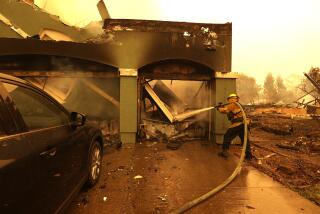Lloyd’s Head Sees Liability Crisis Ending
- Share via
The chairman of Lloyd’s of London, which operates the world’s largest insurance market, voiced guarded optimism Thursday about the U.S. liability insurance industry, which has been marked by soaring premiums and a shortage of some forms of protection.
But, Peter Miller warned, a crisis that was nearly a decade in the making will not be cured by the six months of higher profits reported this year by many U.S. insurers.
“There is a crisis of confidence on the insurers’ part,” Miller said in an interview here. “We’re dead scared. We lost a lot of money.”
Miller said he based his optimism largely on the sharply higher premiums being charged during the last two years, after about six years of rampant rate slashing, but also on efforts to reform civil law already taken or actively under consideration in about 40 of the 50 states. However, he added, much uncertainty remains to feed fears that courts may still interpret insurance contracts in ways that insurers never intended.
Societal Problem
“If to the uncertainty of risk you add the uncertainty of court interpretation, then you are putting your money into something that’s a double or even a triple hazard,” he said. “This isn’t really an insurance problem; it’s societal.” Miller explained that the idea of penalizing wrongdoers for the results of their actions--the so-called tort system--has been “distorted” into a system of compensating victims from whatever sources seem to have the best ability to pay--often insurers.
The underwriting results turned in by the investor syndicates operating through Lloyd’s facilities suggest some improvement in its general liability category, one of nine classes of insurance it handles. For the third straight year, general liability insurance operations resulted in paying out more in claims than the 298-year-old exchange collected in premiums in 1983. (The books were closed this year on 1983 because Lloyd’s normally leaves accounts open for three years to allow for late claims.) But the loss, Miller emphasized, was 39% smaller than 1982’s.
While Miller said he expects 1984 to be about the same as 1983, “the trends now are favorable, and I am optimistic--quite optimistic, really--about 1985.
“But, he added, “I’m also very cautious . . . because the trouble with liability accounts is that they take so long to show their colors.”
Small Profit for 1983
Lloyd’s reported a hair-thin net profit of 1.4% for 1983 despite the fact that all other forms of insurance that it writes were profitable. “There were enormous losses in general liability--and substantially because of the casualty crisis in the United States,” Miller said.
Though general liability generated just 12% of annual premium income, it accounted for all of the year’s insurance loss. (Investment income and profits in the other eight classes of insurance barely offset that loss.)
Although U.S. property-casualty insurers reported much stronger results for the first half of this year, Miller said, most of them continue to pay out more than they take in as insurance premiums. “To think the battle is won is a delusion,” he cautioned. “There is no way, on the basis of that short run, to tell how it’s going.”
Lloyd’s is just completing its move into ultramodern new quarters this week, Miller said. The dramatic structure--designed by Richard Rogers, architect of Paris’ Pompidou Center--is built around a central atrium rising 200 feet above the huge Underwriting Room, where brokers seek to obtain insurance from syndicates of investors willing to “underwrite” a portion of the risk.
The atrium is surrounded by a series of glass-walled galleries offering working space for underwriters and the staff of the insurance exchange.
Despite extensive computerization of the exchange’s operations, Miller said, “eyeball-to-eyeball confrontations” between brokers and underwriters still crowd the 100,000-square-foot Underwriting Room, which has been functioning since May 27.
More to Read
Inside the business of entertainment
The Wide Shot brings you news, analysis and insights on everything from streaming wars to production — and what it all means for the future.
You may occasionally receive promotional content from the Los Angeles Times.









